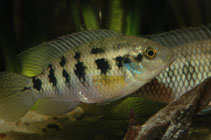| Family: |
Cichlidae (Cichlids), subfamily: Pseudocrenilabrinae |
| Max. size: |
8.8 cm SL (male/unsexed) |
| Environment: |
demersal; freshwater; pH range: 6 - 8; dH range: 5 - 19, |
| Distribution: |
Africa: from coastal basins in Ivory Coast (rivers Agnébi, Me, Bia, Comoé, Tano) to forested coastal lowlands in Nigeria (Ogun, Oshun, Niger delta, Ethiop, Calabar, Great Kwa and lower Cross) including the Ouémé in Benin (Ref. 53405, 81260). Also reported from Ogowe basin in Gabon (Ref. 81260). Reports from Kouilou-Niari in Republic of Congo (Ref. 81260) refer to Thysochromis emili (Ref. 122428). |
| Diagnosis: |
Dorsal spines (total): 13-16; Dorsal soft rays (total): 9-11; Anal spines: 3-3; Anal soft rays: 7-9. Description: deep-bodied (35.8-47.0% SL); head relatively large (length 31.7-40.2% SL); mouth terminal, small (Ref. 81260). Snout slightly rounded, jaws equal (Ref. 53405). Jaws with outer row of evenly spaced conical, unicuspid teeth, 2-4 inner rows (Ref. 53405, 81260). Pharyngeal jaw teeth bicuspid (Ref. 53405). Caudal peduncle short, deeper than long; 2.5-3 scales between upper lateral line and dorsal fin origin; ceratobranchial rakers feebly tuberculate, epibranchial rakers slender and lanceolate (Ref. 81260). No micro-gillrakers; scales cycloid (Ref. 53405). First pelvic ray longest in males, may reach anal origin; second pelvic ray longest in females, rarely approaches anal origin; dorsal and anal soft rays more elongate in males than females (Ref. 81260).
Coloration: in life: head and back golden-beige, sides silvery-beige, sometimes with rosy-violet hues (Ref. 53405). Scales dark-edged; belly pale beige (Ref. 53405, 81260). Middle of sides with 4-7 large, irregular spots (Ref. 52307, 53405, 81260), some coalesced into an incomplete mid-lateral band (Ref. 53405, 81260). 3-5 smaller spots between large mid-lateral spots and dorsal fin, more or less distinct depending on state of the fish (Ref. 53405, 81260). Dark band from eye to upper jaw (Ref. 53405). Lower opercle and cheek often with bluish flush; pelvic fins purplish red in both sexes with light blue margin; bluish white margin to dorsal, and upper half of caudal fin (Ref. 81260). Males: soft parts of dorsal and anal fins, as well as caudal fin, covered with small spots forming reticulate pattern; distal margin of spinous part of dorsal fin red, with iridescent blue submarginal band that extends unto margin of soft part of fin; upper margin of caudal of same colour as dorsal-fin margin; pelvic fins greyish, anterior margin bluish-black (Ref. 53405). Females: reticulate pattern on vertical fins reduced or absent; margins of dorsal and caudal fins usually brighter red than in males; series of 5-7 silvery-white scales just above belly (Ref. 53405). Sexually active females with purple-red belly and silvery spot in anal region; unpaired fins of females without coloration or sometimes light purple (Ref. 81260). |
| Biology: |
Pair-bonding, substrate brooder which spawns preferentially in caves or cave-like structures (Ref. 52307, 81260). Maximum TL was recorded at 12.0-13.0 cm (Ref. 5706). |
| IUCN Red List Status: |
Least Concern (LC); Date assessed: 22 April 2019 Ref. (130435)
|
| Threat to humans: |
harmless |
Source and more info: www.fishbase.org. For personal, classroom, and other internal use only. Not for publication.

